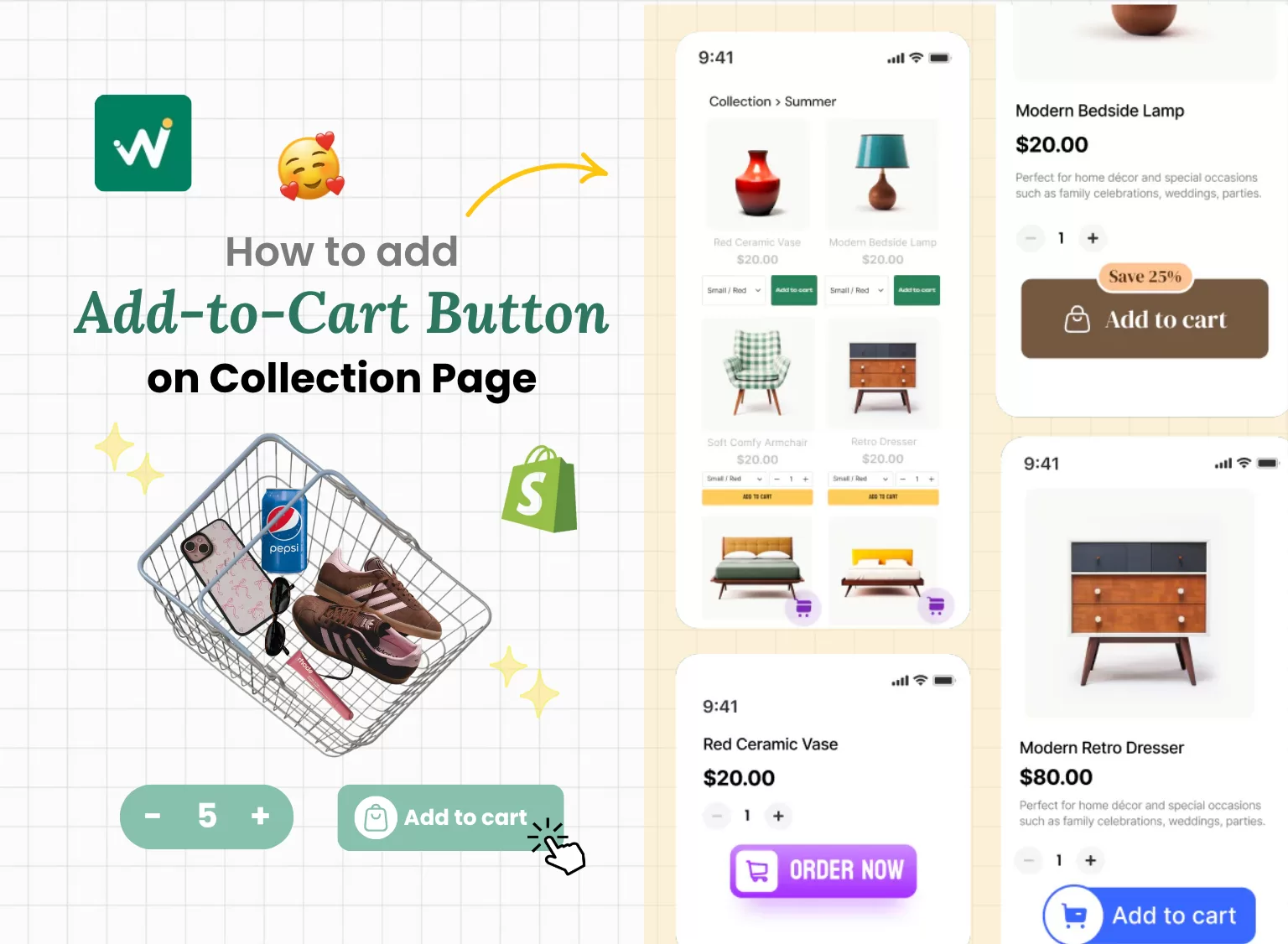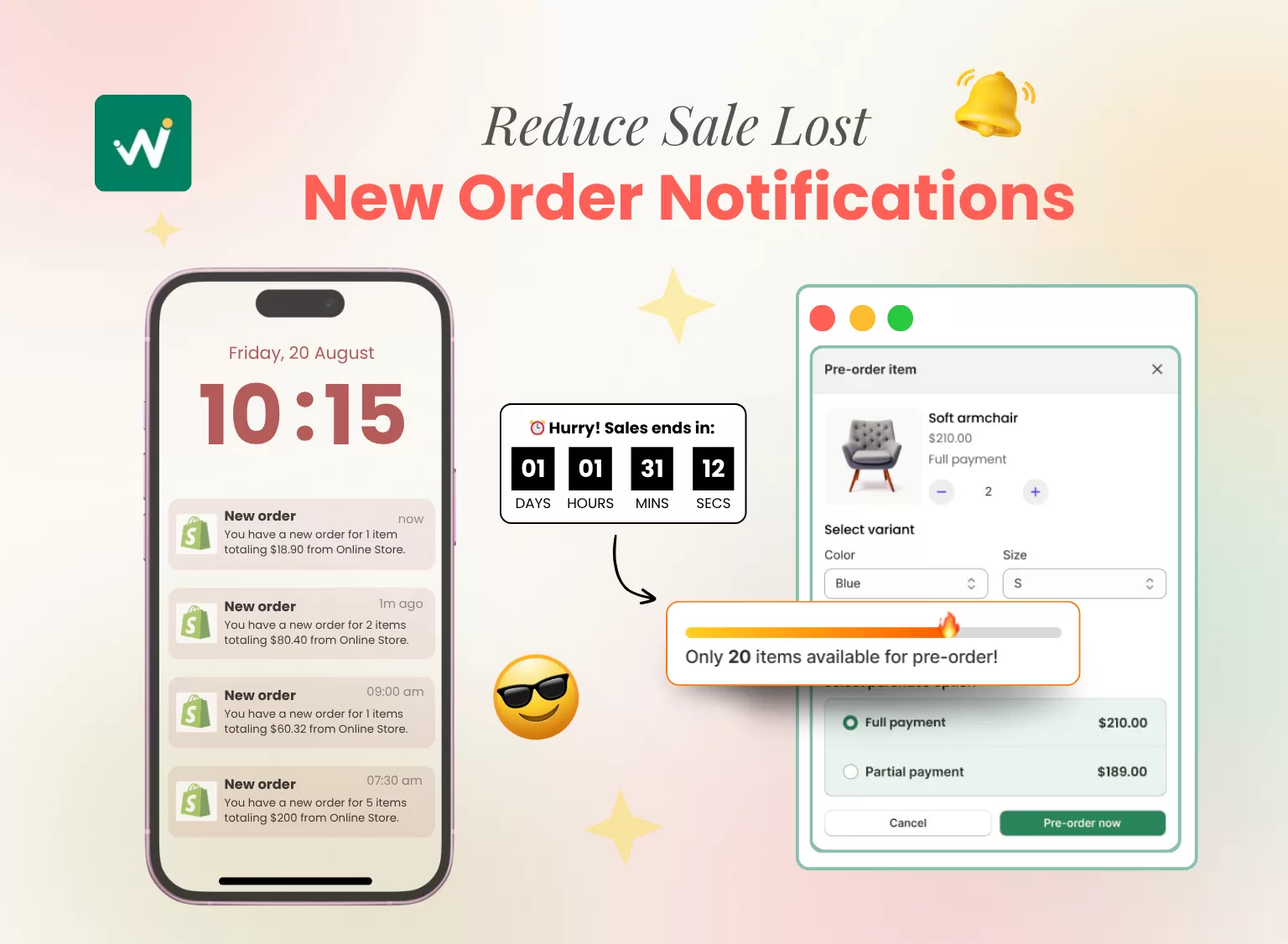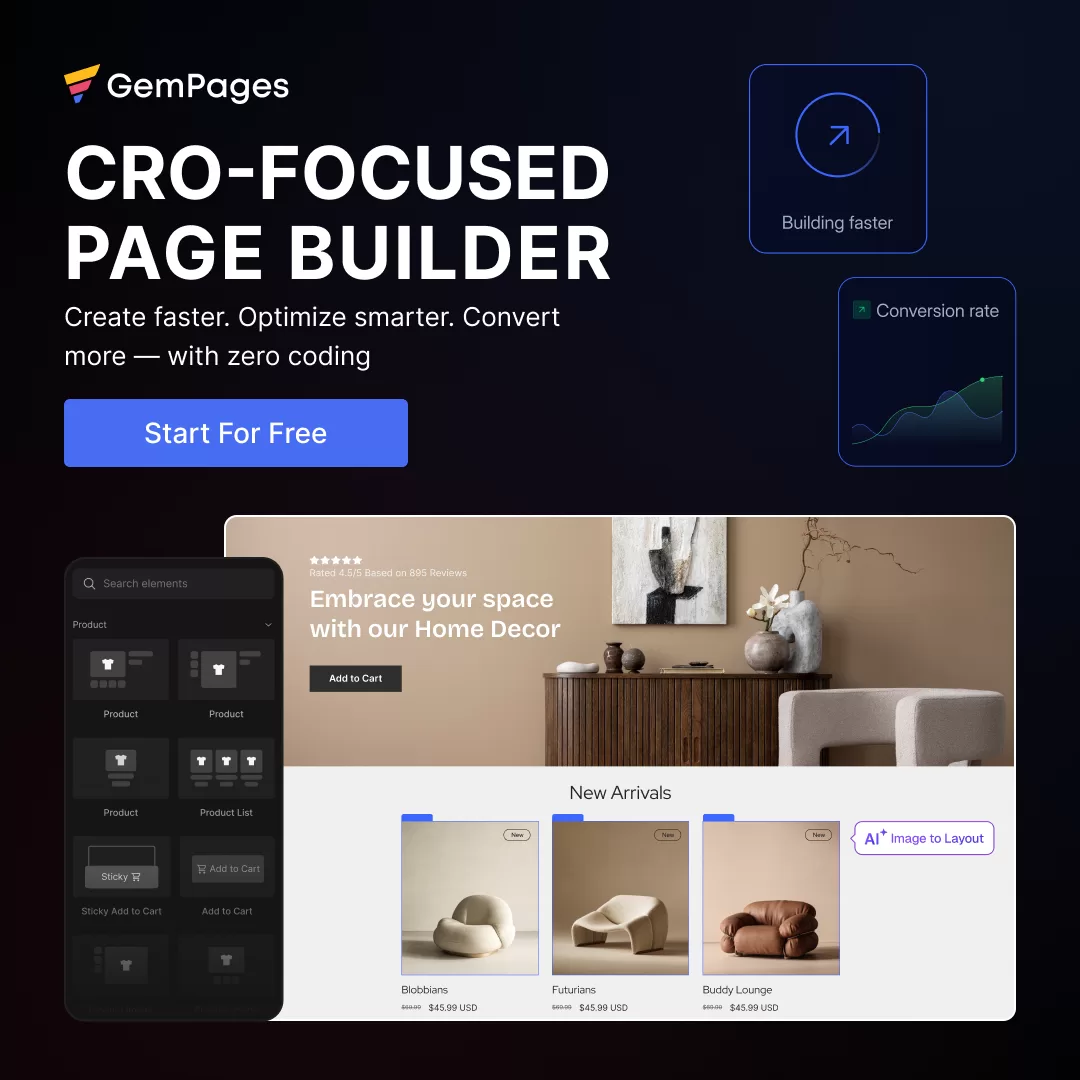Struggling to grow your Average Order Value on Shopify? You might just need the right offer at the right time. Many online stores are leaving money on the table by not leveraging upsells properly, missing out on opportunities to increase revenue from existing customers.
This blog will show you exactly how to add upsell products to your Shopify store the right way, helping you boost your Average Order Value (AOV), encourage repeat purchases, and enhance customer loyalty – all without requiring any coding skills.

1. What is an Upsell in Shopify and why does it matter?
Upselling encourages customers to purchase a more expensive or premium version of the product they’re already considering. The goal is to increase the order value by convincing customers that the upgraded option provides better value, quality, or features.
- Example: A customer selects a twin-size mattress → You recommend the queen size that’s currently on sale
Downselling is the strategy of offering a less expensive alternative when a customer hesitates or shows resistance to the original price. This technique helps retain customers who might otherwise leave without purchasing anything.
- Example: Someone hesitates at a $200 jacket → You suggest a similar style for $120
Cross-selling involves suggesting complementary or related products that enhance the customer’s primary purchase. Instead of upgrading what they’re buying, you’re adding items that work well together or complete their shopping needs.
- Example: A customer buys a laptop → You suggest a laptop bag, wireless mouse, and screen protector
Why can your business benefit from upselling?
- Increases Average Order Value (AOV)
Upselling directly boosts the amount customers spend per transaction by encouraging them to choose higher-value options. When a customer upgrades from a basic product to a premium version, your revenue from that single transaction increases immediately without acquiring additional customers. This improvement in AOV compounds over time significantly impacts your overall revenue growth and makes each customer interaction more profitable.
- Reduces Customer Acquisition Costs
It’s significantly cheaper to sell more to existing customers than to find new ones, with studies showing it costs 5-25 times more to acquire a new customer than to retain an existing one. Upselling maximizes the value you get from customers you’ve already invested in acquiring, improving your return on marketing spend. This cost efficiency allows you to allocate more resources to product development, customer service, or other growth initiatives instead of constantly chasing new prospects.
- Improves Profit Margins
Premium products and services typically have higher profit margins than basic offerings, making upselling extremely valuable for bottom-line growth. When customers choose upgraded versions, you’re not just increasing revenue, you’re often earning disproportionately more profit per sale. This margin improvement helps businesses weather economic downturns, invest in innovation, and build stronger financial foundations for long-term success.
- Enhances Customer Lifetime Value (CLV)
Customers who accept upsells tend to become more engaged with your brand and more likely to make repeat purchases over time. These customers often develop stronger loyalty because they’ve invested more in your products and experienced the enhanced value of premium offerings. By increasing both the immediate transaction value and the possibility of future purchases, upselling significantly boosts the total revenue you’ll earn from each customer relationship.
2. Methods to add upsell products in Shopify
- Native Shopify Product Recommendations
Shopify’s built-in recommendation system is the simplest way to start upselling without any additional apps or coding.
How it works:
- Shopify automatically displays “You may also like” sections on product pages
- Uses customer browsing behavior and purchase history to suggest relevant products
- Appears on product pages, cart pages, and checkout
Best for:
- New stores just starting with upselling
- Businesses with limited budgets
- Stores with clear product relationships
Limitations:
- No customization of recommendation logic
- Can’t create specific upsell rules or promotions
- Limited control over placement and design
- Product Bundles with Discounted Pricing
Create compelling product packages that offer customers better value while increasing your average order value.
How it works:
- Group related products together at a discounted price compared to buying individually
- Show clear savings to motivate purchases (e.g., “Save $25 when you buy the complete set”)
- Examples: Camera + lens + memory card bundle, or clothing set with shirt + pants + shoes
Implementation steps:
- Identify products frequently bought together
- Create bundle products in Shopify or use apps like “Frequently Bought Together”
- Price bundles 10-20% below individual item totals
- Display savings prominently on product pages
Best for:
- Stores with complementary product lines
- Simplifying customer decision-making
- Moving slower inventory items
- Electronics, fashion, beauty, and home goods stores
- BOGO (Buy One Get One) Promotions
BOGO offers are highly effective for increasing order values while providing clear customer value.
Effective BOGO strategies:
- Buy 2 Get 1 Free on bestselling items
- Buy X Get Y (different products) to introduce new items
- Tiered offers: Buy 2 Get 10% off, Buy 3 Get 20% off
- Free gift with purchase over certain amount
How to implement:
- Use third-party apps for advanced rule creation
- Set up automatic cart additions for qualifying purchases
- Display BOGO offers prominently on product pages and cart
Best for:
- Fashion and beauty stores
- Seasonal promotions and clearance sales
- Stores with good inventory depth
- Building customer loyalty programs
- Strategic Pop-up Upsells with Urgency
Use well-timed pop-ups to present irresistible upsell offers at crucial moments in the customer journey.
Effective pop-up strategies:
- Exit-intent pop-ups: Offer upgrades when customers are about to leave
- Cart abandonment pop-ups: Present last-chance upsells before checkout
- Timed offers: Create urgency with limited-time discounts
- Milestone pop-ups: Trigger offers when customers add items to cart
Best practices:
- Use clear, compelling offers (e.g., “Upgrade to premium for just $10 more”)
- Include countdown timers for urgency
- Make pop-ups mobile-friendly
- Limit frequency to avoid annoying customers
Tools to use:
- Privy, OptinMonster, or Justuno for pop-up creation
- Built-in Shopify Scripts for advanced users
Best for:
- Stores with clear upgrade paths
- Time-sensitive promotions
- Reducing cart abandonment rates
- Free Shipping Threshold Strategy
Encourage larger orders by setting minimum purchase requirements for free shipping and suggesting relevant add-ons.
How it works:
- Set free shipping threshold slightly above your current average order value
- Display progress bars showing how much more customers need to spend
- Suggest relevant, lower-priced items to help reach the threshold
- Example: “Add $15 more for free shipping” with product suggestions below
Implementation tactics:
- Analyze your AOV and set threshold 20-30% higher
- Add free shipping progress bars to cart and product pages
- Create “Add-on” product collections for small items
- Use apps like “Free Shipping Bar” for visual progress indicators
Best for:
- All store types (universally effective)
- Stores with good margins on smaller items
- Building customer loyalty through perceived value
- Tiered Discount Systems
Implement progressive discounts that reward customers for buying more items, creating natural upselling incentives.
Tiered discount examples:
- Buy 1 item: Regular price
- Buy 2 items: 10% off second item
- Buy 3+ items: 15% off third item and beyond
- Volume discounts: 5% off orders $100+, 10% off orders $200+
Advanced tiered strategies:
- Category-specific tiers (e.g., “Buy 3 skincare products, get 20% off”)
- Mix-and-match tiers across product lines
- VIP customer tiers with exclusive discounts
- Seasonal tier adjustments for holidays
Setup methods:
- Use Shopify’s built-in discount system for basic tiers
- Implement apps like “Volume Discounts” for advanced rules
- Create automatic discount codes that apply at checkout
- Display tier benefits clearly on product and cart pages
Best for:
- Fashion and beauty stores with multiple items per category
- B2B stores with volume purchasing
- Stores wanting to increase items per transaction
- Building customer loyalty through reward systems
3. How do businesses apply strategies to add upsell products?
Let’s take a look at how these brands can implement strategies to add upsell products:
- OLIPOP:
OLIPOP is a health-focused beverage brand offering prebiotic sodas that support gut health without compromising on taste. Known for its nostalgic flavors and clean ingredients, OLIPOP has quickly gained popularity among wellness-conscious consumers.
✅ Target Product to Push: Limited edition summer flavors

🎯 Objective: Increase AOV and reduce one-time purchases by converting customers to multi-pack buyers or subscribers.
🛠️ Tactics Used:
- Product Bundles with Discounted Pricing : Create “Summer packs” with seasonal flavors (Orange Cream, Cherry Cola, Strawberry Vanill,and Cream Soda) at a 15% discount.
- Tiered Discount System: “Buy 2 get 10% off, Buy 3 get 20%” to encourage volume.
- Free Shipping Threshold: Raised to $50 – just above the average 2-pack bundle.
- Kylie Cosmetics
Kylie Cosmetics, founded by Kylie Jenner, is a beauty brand best known for its viral Lip Kits and trend-driven product launches. With a strong social media presence and celebrity influence, the brand excels in creating hype and moving large volumes of product quickly.
✅ Target Product to Push: Older Lip Kit shades from previous seasons (e.g., limited edition packaging or slow-sellers)

🎯 Objective: Clear stagnant inventory without devaluing the brand or running traditional clearance sales.
🛠️ Tactics Used:
- BOGO Promotions: “Buy 1 Lip Kit, Get 1 Free” — pairing underperforming SKUs with bestsellers.
- Free Shipping Threshold: Set at $40 to encourage multiple BOGO sets.
💡 The good news? You can use the BOGO+ Buy X Get Y & Free Gift app by WizzCommerce brings all of these high-impact features into one simple solution for your Shopify store:
Advanced Upselling Strategies using BOGO+
- Time-limited offers (e.g., “Buy X Get Y Today Only”): Time constraints encourage immediate action and can significantly boost conversion rates.
- Tiered upsells: the more they buy, the more they get
- Spend $50: Free shipping
- Spend $75: Free shipping + 10% off
- Spend $100: Free shipping + 15% off + free gift
- Mystery gift campaigns to drive curiosity
- Pair with discount codes or free shipping
👉 Read here to find out several amazing features of BOGO+!
4. Common Mistakes to Avoid When Upselling in Shopify
Even with the right tools, several pitfalls can undermine your upselling efforts:
Irrelevant Product Pairings
One of the most damaging mistakes is recommending upsell products that don’t align with the customer’s original intent. Just because an item is expensive or high-margin doesn’t mean it’s a good fit.
For example, offering car accessories to someone buying herbal tea creates confusion and erodes trust.
Successful upsells should feel thoughtful, relevant enhancements, not random add-ons.
Poor Mobile UX from Third-Party Apps
Many upsell apps were initially built for desktop experiences and don’t translate well to mobile, where over 70% of eCommerce traffic now originates. Slow-loading modals, overlapping popups, or broken design elements can frustrate users and lead to cart abandonment. Before committing to an app, always test how it behaves on mobile devices. A mobile-first, responsive design is no longer optional — it’s essential.
Plugin Overload
Trying to stack multiple upsell or discount plugins can hurt your site more than it helps. Each app adds scripts that can slow down loading speed, create layout conflicts, and even interfere with one another’s functionality. Worse, a cluttered upsell experience overwhelms shoppers and reduces conversion rates. It’s smarter to invest in one all-in-one solution that handles various upselling needs cleanly and efficiently.
Misusing Free Gift Campaigns
Free gift offers can be incredibly effective — but only when used strategically. Giving away items that customers don’t find valuable (or already associate with being cheap) can lower your brand’s perceived quality.
For example, offering a generic keychain with a $100 skincare purchase may confuse the customer rather than delight them.
Instead, ensure that your free gifts are relevant, complementary, and clearly positioned as added value rather than inventory dumps.
💡Remember: The goal is to increase order value while maintaining your products’ perceived worth and brand positioning.
5. Conclusion
In conclusion, upselling can benefit businesses by helping them to increase AOV, profit margins, or improve customer lifetime value, as well as reduce customer acquisition costs. However, this is not the only strategy to gain profit. Brands need to be flexible in applying other strategies, like downsell or cross-sell, depending on their business context and products.
How useful was this post?
Click on a star to rate it!
Average rating 5 / 5. Vote count: 1
No votes so far! Be the first to rate this post.
Sophia Dao is a Shopify Conversion Specialist at WizzCommerce, specializing in e-commerce and Shopify solutions. With a passion for digital marketing and a keen eye for detail, Sophia creates engaging content that helps businesses thrive online. When she’s not writing, she enjoys exploring the latest trends in tech and commerce. Follow Sophia for practical e-commerce tips and the latest marketing insights!






